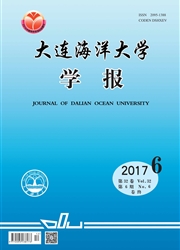

 中文摘要:
中文摘要:
为研究不同驯化温度对体质量为(6.26±0.21)g的施氏鲟Acipenser schrenckiiBrandt幼鱼肝脏线粒体代谢的影响,将试验分为8个温度驯化组,分别设16、19、22、25℃4个恒温组,以及(16±2)、(19±2)、(22±2)、(25±2)℃4个变温组,驯化6周后取样,分别测定各驯化组施氏鲟幼鱼肝脏组织线粒体的蛋白含量、呼吸率和细胞色素C氧化酶(CCO)活性。结果表明:施氏鲟肝脏组织线粒体蛋白含量在各驯化组间均无显著性差异(P〉0.05);鱼体肝脏组织线粒体状态3呼吸率和状态4呼吸率均随着驯化温度的升高显著增加(P〈0.05),在16℃和19℃驯化组中,恒温处理和变温处理间均无显著差异(P〉0.05),而在22℃和25℃驯化组中,变温驯化组的线粒体状态3呼吸率和状态4呼吸率均显著高于恒温驯化组(P〈0.05);鱼体肝脏组织线粒体的呼吸控制率(RCR)随驯化温度的升高呈显著降低的趋势(P〈0.05),在各温度驯化组中,线粒体的RCR在恒温和变温处理间均无显著性差异(P〉0.05);鱼体肝脏组织线粒体CCO活性随着驯化温度的升高显著增加(P〈0.05),但酶活性在恒温和变温处理间均无显著性差异(P〉0.05)。研究表明,20~27℃的变温驯化能够显著诱导施氏鲟线粒体呼吸率升高。
 英文摘要:
英文摘要:
The aim of this study is to investigate the effects of different acclimation temperature on mitochondrial metabolism in liver of juvenile Amur sturgeon Acipenser schrenckii Brandt with body weight of (6. 26±0. 21)g. The mitochondrial protein contents, mitochondrial respiration rates and mitochondrial cytochrome C oxidase activity (CCO) were measured in liver of the fish acclimated at constant temperature of 16,19,22 and 25 益 and four var-iable temperature (16±2),(19±2),(22±2) and (25±2)益 for 6 weeks. The results showed that there were no significant differences in mitochondrial protein contents in the fish between acclimation groups ( P〉0.05). Howev-er ,the mitochondrial state 3 and state 4 respiration rates were found to be increased significantly with increases in acclimation temperature ( P〈0.05),without significant differences in acclimation groups of 16℃ and 19 ℃(P〉 0.05),even though there were significant higher mitochondrial respiration rates in variable temperature groups than those in constant temperature groups in acclimation groups of 22℃ and 25℃(P〈0. 05). The RCR values of mi-tochondrial respiration in liver were declined significantly with increases in acclimation temperature ( P 〈0. 0 5 ), without significant differences between constant temperature groups and variable temperature groups in all acclima-tion temperature ( P 〉0. 05). With increases in acclimation temperature,the mitochondrial CCO activities were in-creased significantly (P〈0.05),without significant differences between constant temperature groups and variable temperature groups ( P 〉0. 05 ). The findings indicate that variable temperature acclimation from 20 ℃ to 27 ℃ can lead to significantly induce increases in mitochondrial respiration rates in liver of juvenile Amur sturgeon.
 同期刊论文项目
同期刊论文项目
 同项目期刊论文
同项目期刊论文
 期刊信息
期刊信息
